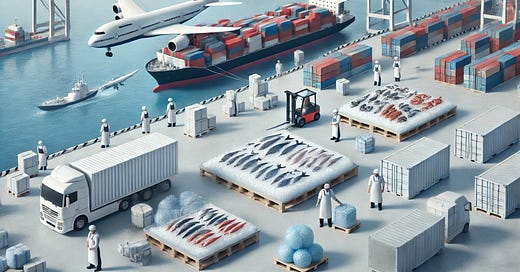Captain Fresh: Reinventing Global Seafood Through Tech and Scale
In just five years, Captain Fresh has evolved from a domestic seafood aggregator into a global B2B powerhouse, supplying markets across the US, Europe, and Southeast Asia. Built on an asset-light model and technology-driven supply chain, the company has carved out a competitive edge in an industry long dominated by traditional wholesalers. Now, as it prepares for a $1 billion IPO in 2025, Captain Fresh is entering a new phase—one that will test whether its differentiated approach can deliver long-term dominance in the global seafood trade.
Captain Fresh’s early ambition was to modernize India’s fragmented seafood supply chain by directly linking fisherfolk with retailers. The company introduced tech-driven procurement and logistics tools, giving smaller suppliers better access to formal markets while streamlining inventory management for retailers. But by 2022, it was clear that the domestic market—plagued by inefficiencies, payment delays, and high wastage—was limiting growth. The company responded by phasing out its India operations and shifting focus to international markets, where demand was more stable, and margins were stronger.
The pivot has since paid off. By FY24, 98% of the company’s demand came from exports, revenue jumped 70% YoY to Rs 1,395 crore, and net losses shrank by 29% to Rs 229 crore. Today, Captain Fresh sources seafood from India, Southeast Asia, Europe, and Latin America, supplying a wide range of buyers, from large wholesalers to restaurant chains and grocery retailers.
A key component of its expansion strategy has been acquisitions. In recent years, Captain Fresh has strengthened its presence in key seafood hubs by acquiring Poland’s Koral, Indonesia’s Fishlog, and Illinois-based CenSea. This approach has allowed it to rapidly integrate global supply chains while optimizing underutilized seafood processing facilities. Unlike traditional seafood wholesalers that require heavy capital investment in owned factories and logistics networks, Captain Fresh has focused on building a flexible and technology-driven supply chain, enabling it to scale efficiently without being burdened by asset-heavy operations.
A Competitive Edge
Unlike legacy seafood traders who rely on fixed supply chains and manual operations, Captain Fresh has built its business around adaptability and data-driven insights. Its proprietary ERP system and real-time pricing tool, Fishgram, provide dynamic market intelligence that helps balance supply and demand—a critical advantage in an industry where price fluctuations and inventory mismanagement can quickly erode margins.
By leveraging AI and analytics, Captain Fresh optimizes sourcing, minimizes wastage, and ensures price transparency for both suppliers and buyers. This has been particularly valuable in international markets where seafood prices vary significantly based on seasonality, trade policies, and logistics costs.
The asset-light strategy is also delivering financial benefits. Over the last 2.5 quarters, Captain Fresh has achieved an EBITDA of $22 million-$23 million, signaling that its operational efficiencies are beginning to pay off at scale. With the US contributing $400 million of its projected $525 million-$550 million revenue for FY25, the company has firmly established itself as a major player in international seafood trade.
Captain Fresh’s upcoming IPO—targeting a $1.3-$1.5 billion valuation—will provide the capital needed to deepen its presence in Western markets. The fresh funds are expected to support further acquisitions, reinforce its global supply chain network, and potentially expand into value-added seafood products, which carry higher margins than raw seafood exports.
Beyond its core B2B model, Captain Fresh is also eyeing a long-term push into B2C sales in the US and Europe. Direct-to-consumer seafood sales could allow the company to unlock higher margins and build brand loyalty, but the shift introduces new challenges. Unlike B2B, where transactions are bulk-driven, B2C would require investments in consumer marketing, packaging, and compliance with retail food regulations.
The real test for Captain Fresh will be maintaining its competitive advantage as it scales. Unlike SaaS or IT services, seafood remains a high-risk, low-margin industry where operational discipline is critical. While its technology-first approach has been a differentiator so far, execution will be key in ensuring that it does not fall into the same traps as traditional seafood players—over-reliance on specific geographies, supply chain disruptions, and fluctuating consumer demand.
If it plays its cards right, Captain Fresh could redefine global seafood distribution, much like India’s IT firms reshaped enterprise technology. It could cement its position as a dominant player in the industry by continuing to integrate its supply chains, optimize logistics, and execute strategic acquisitions. However, if its expansion outpaces its operational efficiencies, it risks becoming another high-growth startup that struggles with profitability at scale. The next few years will determine whether Captain Fresh emerges as an enduring global leader or faces the same consolidation pressures that have shaped the seafood industry for decades.




